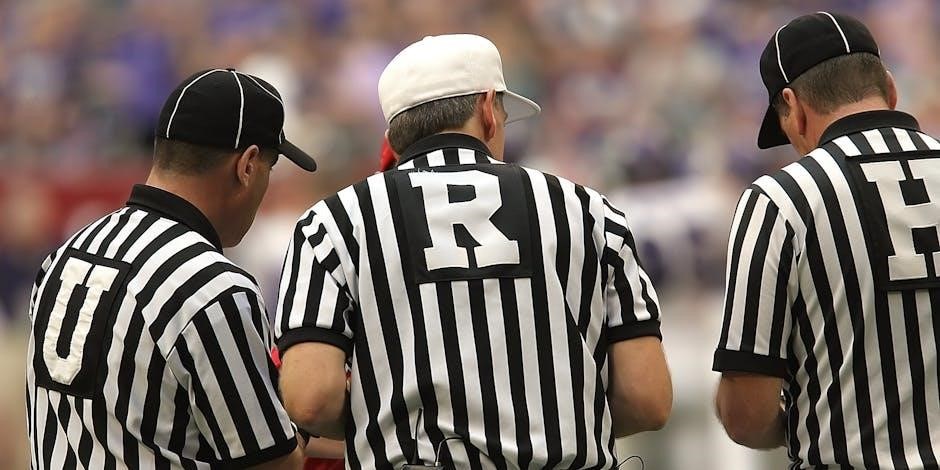Canasta is a popular card game requiring strategy and teamwork. This guide provides structured rules and gameplay tips. Download a printable PDF for easy reference and quick start.
Overview of the Game
Canasta is a strategic and entertaining card game played with two decks of 108 cards, including wild cards like jokers and 2s. It involves forming valid melds of groups or runs to score points. The game emphasizes teamwork, as players partner up to create canastas—sets of seven or more cards of the same rank. A printable PDF guide is essential for quick reference, outlining rules, scoring, and setup. Whether you’re a beginner or an experienced player, having a clear set of rules ensures smooth gameplay and fair competition. Download your PDF today to master Canasta’s exciting mechanics!
Importance of Printable PDF Rules
Printable PDF rules are indispensable for ensuring clarity and consistency in Canasta gameplay. They serve as a reliable reference, detailing card values, scoring systems, and special conditions. With a PDF, players can quickly verify rules during disputes or for learning purposes. The standardized format ensures everyone follows the same guidelines, fostering fair play and eliminating confusion. Whether hosting a tournament or casual game, having a downloadable PDF guarantees that all participants are on the same page. Accessible and concise, printable rules enhance the overall Canasta experience, making it more enjoyable for all players involved. Download your PDF today for seamless gameplay!

Number of Players and Teams
Canasta is typically played with 4 players in 2 teams of 2. A 5-player variation is also possible with specific rule adjustments for team dynamics.
4-Player Canasta (2 Teams of 2)
In 4-player Canasta, the game is divided into two teams of two players each. Each player receives 15 cards, and the objective is to score points by making canastas. A canasta is a meld of at least seven cards of the same rank. Teammates must work together to accumulate points by melding cards and forming valid canastas. Strategy and coordination are key, as communication between partners is essential. The game setup involves two decks of 108 cards, including wild cards (2s and jokers), and begins with dealing the cards evenly. Initial moves involve melding cards to start scoring.
5-Player Canasta (Alternative Setup)
In a 5-player Canasta setup, the game is played with three teams of one player each, leaving one player out of the round. This variation allows for flexibility in group sizes and is ideal when an odd number of players is present. The rules remain largely consistent with the 4-player version, but adjustments are made to accommodate the lone player. Each player still receives 15 cards, and the objective remains to score points by forming canastas. The game proceeds similarly, with melding and scoring rules applying uniformly. This setup ensures inclusivity and maintains the game’s dynamic nature, even with an uneven number of participants.
Equipment Needed
Canasta requires two standard decks of 108 cards each, including jokers, totaling 216 cards. Wild cards include 2s and jokers, essential for gameplay and strategy.
Deck Composition (2 Decks of 108 Cards)
Canasta is played with two standard decks of 108 cards each, totaling 216 cards. Each deck includes 52 standard cards and 4 jokers, ensuring a dynamic gameplay experience. The cards are divided into four suits, with ranks ranging from Ace to King. Wild cards, such as 2s and jokers, are essential for forming melds and adding strategy; The dual-deck system allows for a wider variety of combinations and longer games. Printable PDF rules often specify the exact composition to ensure consistency. Proper deck preparation is crucial for a fair and enjoyable game.
Wild Cards in Canasta (2s and Jokers)
In Canasta, wild cards play a crucial role in forming melds. Both 2s and jokers are designated as wild, allowing them to substitute for any card in the deck. This flexibility enhances strategy, enabling players to complete sets or runs more easily. However, when a wild card is used in a meld, it increases the difficulty of creating a pure canasta. Printable PDF rules often highlight wild card usage to ensure clarity. Proper handling of wild cards is essential for mastering the game and maximizing scoring opportunities. Their inclusion adds depth and complexity to the gameplay experience.

Objective of the Game
The goal is to score points by making canastas, which are melds of seven or more cards of the same rank. Teams earn bonuses for completing multiple canastas.
Goal: Score Points by Making Canastas
The primary objective in Canasta is to accumulate points by forming and laying down canastas, which are sets of seven or more cards of the same rank. Points are earned for each card in a canasta, with higher-value cards contributing more to the score. Additionally, bonuses are awarded for completing multiple canastas in a single hand, further increasing a team’s total. Teams must strategically meld cards to maximize their score while minimizing penalties from unmelded cards. A printable PDF guide can help players track scoring and ensure adherence to the rules for a fair and enjoyable game.
Setup and Dealing Cards
Before the game begins, the deck is shuffled, and each player receives 15 cards. The remaining cards are placed face down in a draw pile, with the top card turned over to start the discard pile. If the top card is a wild card (2 or Joker), it sets the discard pile’s suit. Players organize their hands, ensuring all cards are visible only to them. The dealer starts the game, and play proceeds clockwise. A printable PDF guide can outline these steps clearly, helping new players understand the setup process and ensuring a smooth start to the game.
Initial Moves and Melding
The game begins with the player to the dealer’s left. They must draw a card or take the entire discard pile if they can use the top card in a meld. Melding involves laying down groups of three or more cards of the same rank or runs of consecutive cards in the same suit. Wild cards (2s and Jokers) can substitute for any card. A player must meld at least three cards to start, and subsequent melds can add to existing ones. A printable PDF guide can detail these rules, ensuring players understand how to initiate and build melds effectively for maximum points.

Melding and Canastas
Melding involves grouping cards into sets or runs. A canasta requires seven cards of the same rank. Wild cards (2s and Jokers) can substitute. A printable PDF guide helps clarify these rules.
Valid Melds: Groups and Runs
A valid meld consists of a group (three or more cards of the same rank) or a run (three or more sequential cards of the same suit). Groups are the most common type of meld, while runs add variety and strategy. Wild cards (2s and Jokers) can substitute for missing cards in a meld but cannot replace all natural cards. A meld must include at least two natural cards to be valid. For example, a group of four 7s or a run of 3-4-5 of hearts are valid melds. Mixed canastas (containing wild cards) are allowed, but pure canastas (no wild cards) score higher. A printable PDF guide can help clarify these rules for new players.
Types of Canastas: Mixed vs. Pure
A Canasta is a meld of at least seven cards of the same rank. A Mixed Canasta includes wild cards (2s or Jokers), while a Pure Canasta consists entirely of natural cards. Pure Canastas score higher, typically awarding a 500-point bonus, compared to Mixed Canastas, which may award 300 points. To achieve a Pure Canasta, players must avoid using wild cards. Printable PDF guides clarify these distinctions, ensuring players understand the scoring and strategic differences. These resources are invaluable for mastering the game, whether you’re a newcomer or an experienced player.
Scoring Points
Points are scored by making Canastas and earning bonuses. Each card’s value contributes, with wild cards and 3s affecting totals. Printable PDF rules clarify point allocations and penalties.
Scoring for Cards and Bonuses
Each card has a specific point value, with wild cards (2s and Jokers) worth 20 points. Number cards and face cards score based on their rank, while 3s serve as bonuses or penalties. A Canasta earns a 500-point bonus, and going out awards an additional 100 points. Unmelded cards in hand deduct points, with 3s penalized if no Canasta is made. The downloadable PDF rules provide a detailed scoring chart for easy reference, ensuring accurate point tracking during gameplay. This system balances strategy and luck, making every card count.
Penalties for Unmelded Cards
Any cards left in a player’s hand at the end of the game result in penalties. Each unmelded card deducts points from the player’s score. Wild cards (2s and Jokers) and 3s are penalized heavily if not included in a Canasta. If a team has no Canastas, all 3s in their possession count against them. The printable PDF rules outline specific penalties for each card type, ensuring clarity and fair play. These penalties encourage players to meld cards strategically and aim for Canastas to minimize point deductions.
Going Out and End of the Game
The game ends when a player disposes of their last card by melding or discarding. Teams earn bonuses for going out legally and forming Canastas.
Conditions for Going Out
To legally go out, a player must meld or discard the last card in their hand. This can only be done if the player has previously melded or their team has existing melds. The player must have a valid meld to lay down, and the team must agree to go out. If a player goes out illegally, penalties apply, such as losing the game or forfeiting points. Proper communication and strategy between teammates are crucial to meet the conditions for ending the game successfully.
Final Scoring and Winning the Game
After all cards are played, teams tally scores based on melded cards, bonuses, and penalties. Each canasta earns a 500-point bonus, with pure canastas worth more. Points for individual cards are added, and penalties for unmelded cards are deducted; The team with the highest total score wins. If a player goes out legally, their team receives a 100-point bonus. The game can be played to a target score, such as 5,000 points, with the first team to reach it declared the winner. Proper score tracking using a printable PDF ensures accurate and fair results.

Variations and Printable Resources
Explore various Canasta versions and access printable resources like rulebooks, cheat sheets, and scoring guides. These materials ensure clarity and convenience for players of all levels.
Downloadable PDF Rules and Cheat Sheets
Access official Canasta rules and strategies through downloadable PDF guides. These resources include detailed rulebooks, scoring charts, and cheat sheets for quick reference. Find links to PDF files like Canasta Rules.pdf and Canasta Cheat Sheet.pdf online. Many websites offer free downloads, such as Google Drive links or direct downloads from card game communities. These PDFs are ideal for printing and sharing with teammates or opponents. Ensure you have the latest version for accurate gameplay and scoring. Downloadable resources are perfect for both new players learning the basics and experienced players refining their strategies.

